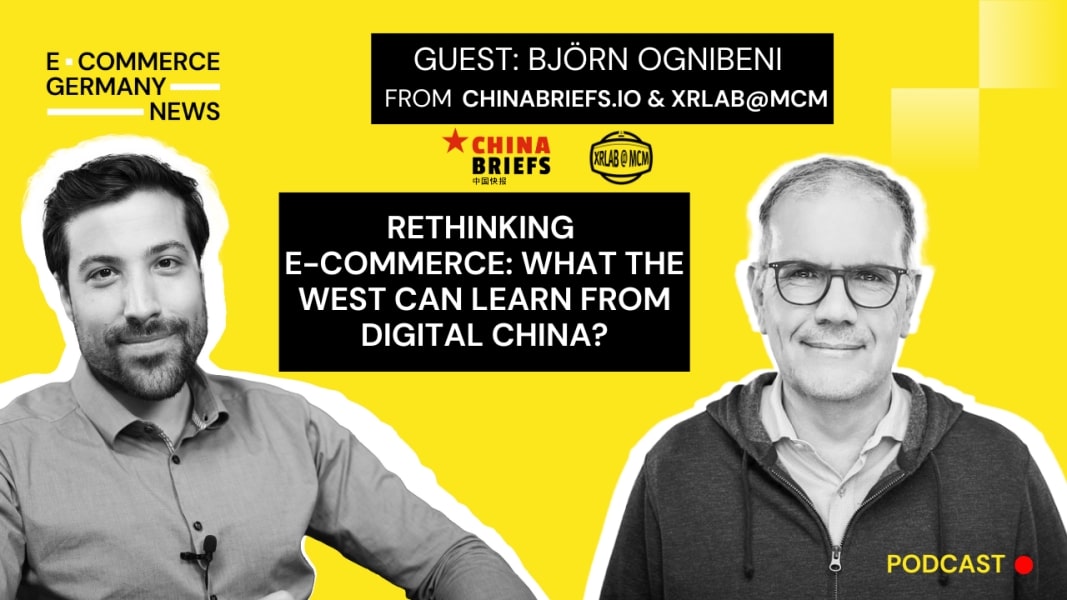Rethinking China’s e-commerce: insights from Björn Ognibeni on the EGN Podcast
Written by
Editorial TeamPublished on
In the latest EGN Podcast, hosted by Efe von Thenen, transformation expert Björn Ognibeni discusses the stagnation of Western e-commerce and the rapid innovation emerging from China.

In the latest episode of the EGN Podcast (autopromotion), Björn Ognibeni, a leading expert on digital transformation and co-founder of ChinaBriefs.io and XRLab@MCM, talked about the evolving landscape of e-commerce. Hosted by Efe von Thenen, the discussion centered around the stagnation of Western e-commerce and the rapid innovation coming out of China. Interested? Learn more below!
Björn Ognibeni began by highlighting a fundamental issue: while e-commerce in the West has remained largely unchanged since its early days in the late 1990s, China has surged ahead with new technologies, business models, and consumer engagement strategies. He explained that most Western brands still operate under a search-driven e-commerce model, where customers know what they want, search for it, and complete their purchase. This model, although functional, has not seen significant innovation in two decades.
In contrast, China has embraced what our guest called “discovery-driven commerce,” a model where platforms focus on engaging customers with new products they might not have initially sought out. He cited platforms like Shein and TikTok as prime examples. On these platforms, users are shown a continuous stream of content and products, often curated through algorithms based on their browsing behavior. This approach transforms shopping from a purely transactional activity into an entertaining and interactive experience, something that has been largely missing from Western e-commerce.
China in the lead
Another major theme of the discussion was the concept of “China speed.” Björn Ognibeni explained that Chinese companies are not only innovating faster but also adapting to market changes with remarkable agility. He gave the example of Shein’s “consumer to manufacturer” (C2M) model, where the company uses consumer data to produce only what is in demand, reducing waste and inefficiency. Unlike traditional Western fashion brands that have to predict trends months in advance and produce large quantities of stock, Shein tests thousands of new designs daily.
The conversation also delved into the cultural differences between China and the West when it comes to consumer behavior. Our guest explained that live shopping—a format that has exploded in China—did not initially succeed in the West because Western companies simply copied the Chinese model without adapting it to local preferences. Live shopping in China is deeply integrated into social platforms, where consumers are accustomed to watching influencers and hosts promote products in real time. In the West, live shopping attempts were often forced into platforms designed for traditional e-commerce, leading to limited engagement. He emphasized that Western brands need to do more than copy Chinese innovations—they need to learn from them and adapt them to fit their own markets.
Exploring is the key to success
As the discussion wrapped up, Björn Ognibeni stressed that Western companies must shed their arrogance toward Chinese competitors and start paying closer attention to their strategies. China’s ability to integrate AI and data-driven decision-making into every aspect of the supply chain, from product design to consumer engagement, has given them a significant edge. Western brands, he argued, should look at how Chinese companies combine speed, efficiency, and creativity to serve their markets.
For him, the future of e-commerce lies in moving beyond the rigid structures that have defined the industry in the West. He urged companies to explore new ways to create excitement around products, integrate social experiences into online shopping, and embrace the idea of continuous iteration and learning from the market. In doing so, he believes Western brands can stay competitive in a rapidly changing digital landscape that is increasingly being shaped by Chinese innovation.
Want to learn more from our guest? Watch the full talk below:
Can’t watch? No problem. It is also available on Spotify and Apple Podcast.
***


